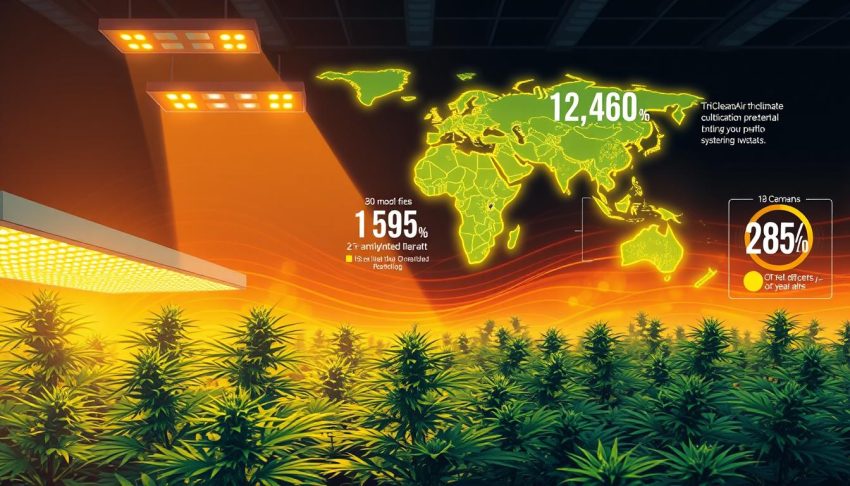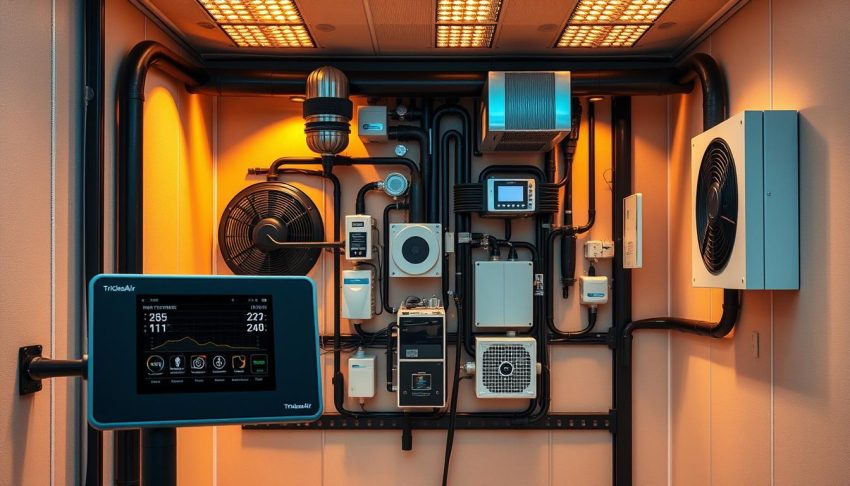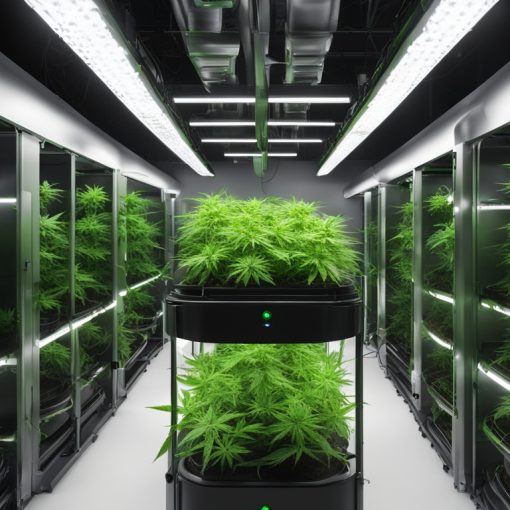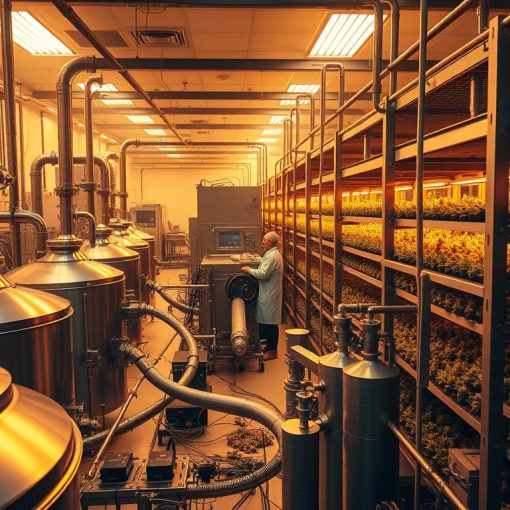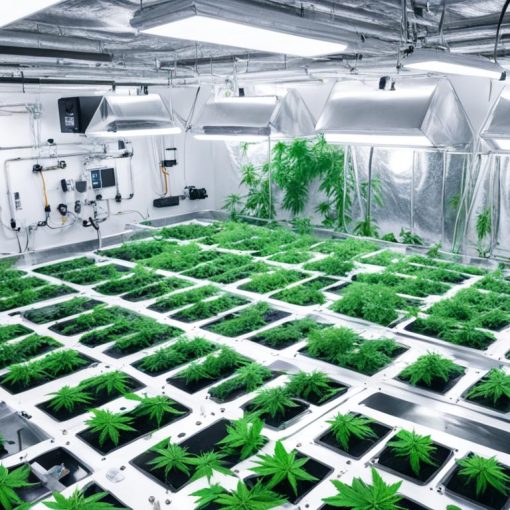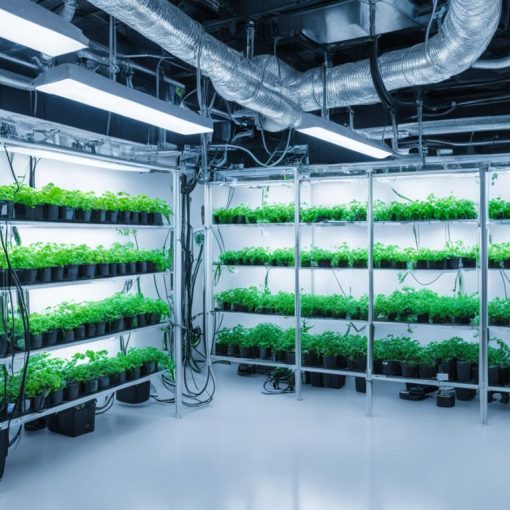Effective cannabis cultivation relies heavily on precise environmental management. By Engineering Cannabis climate control systems, growers can significantly enhance the quality and yield of their crops.
Maintaining optimal conditions is crucial for healthy plant development. Temperature, humidity, and light are critical factors that, when managed correctly, can lead to superior cannabis crops.
Key Takeaways
- Precise climate control improves cannabis quality and yield.
- Advanced systems allow for tailored environmental conditions.
- Optimal temperature, humidity, and light are crucial for healthy cannabis plants.
- Effective climate management leads to superior crop development.
- Investing in engineering climate control can elevate your cannabis grow.
The Science of Environment in Cannabis Cultivation
Climate control is not just about maintaining a stable temperature; it’s about creating an environment that fosters healthy cannabis growth and maximizes cannabinoid production. The science behind environmental factors and their impact on cannabis cultivation is complex and multifaceted.
How Environmental Factors Impact Cannabis Growth
Environmental factors such as temperature, humidity, and light exposure play a critical role in determining the health and productivity of cannabis plants. Optimal temperature ranges vary across different growth stages, and maintaining the right humidity levels is crucial for preventing disease and promoting healthy development.
The Relationship Between Climate and Cannabinoid Production
Research has shown that climate and environmental conditions significantly influence cannabinoid production in cannabis plants. Factors such as temperature fluctuations, light intensity, and CO2 levels can all impact the production of THC and CBD.
| Environmental Factor | Impact on Cannabis | Optimal Range |
|---|---|---|
| Temperature | Affects growth rate and cannabinoid production | 65-75°F (18-24°C) |
| Humidity | Influences disease susceptibility and trichome development | 40-60% RH |
| Light Intensity | Impacts photosynthesis and cannabinoid production | 500-1000 μmol/s |
Cannabis Climate Control: A Comprehensive Overview
Effective climate control is crucial for optimizing cannabis cultivation. By managing environmental factors, growers can significantly impact the quality and yield of their crops.
Key Environmental Parameters for Optimal Growth
The growth and development of cannabis plants are influenced by several key environmental parameters, including temperature, humidity, and light intensity. Optimal temperature ranges vary throughout the growth cycle, with warmer temperatures typically required during the vegetative stage and cooler temperatures during flowering.
Maintaining ideal relative humidity levels is also critical to prevent water stress and reduce the risk of mold and mildew.
The Plant-Environment Interaction Cycle
The interaction between cannabis plants and their environment is a complex cycle. Plants respond to environmental stimuli, such as light and temperature, by adjusting their growth patterns. In turn, the plants’ growth affects the surrounding environment, creating a continuous feedback loop.
Understanding this cycle is essential for developing effective climate control strategies. By monitoring and responding to changes in the plant-environment interaction, growers can optimize growing conditions and maximize yields.
Temperature Management Systems for Professional Grows
Maintaining optimal temperatures is essential for cannabis plants throughout their growth cycle. Temperature fluctuations can significantly impact plant health, yield, and cannabinoid production. A well-designed temperature management system is crucial for professional cannabis cultivation.
Optimal Temperature Ranges Throughout Growth Stages
Cannabis plants have different temperature requirements at various stages of growth.
- During the seedling stage, temperatures should be slightly higher to promote healthy development.
- In the vegetative stage, a moderate temperature range supports vigorous growth.
- During flowering, slightly cooler temperatures can enhance cannabinoid and terpene production.
Understanding these temperature requirements is key to optimizing growth and maximizing yield.
Heating and Cooling Technologies for Grow Rooms
Effective temperature control in grow rooms can be achieved through various heating and cooling technologies.
HVAC Systems Designed for Cannabis Facilities
Heating, Ventilation, and Air Conditioning (HVAC) systems are widely used in commercial cannabis cultivation. These systems provide comprehensive climate control, including temperature regulation, air circulation, and dehumidification.
Energy-Efficient Temperature Control Solutions
To reduce operational costs and environmental impact, many growers are turning to energy-efficient temperature control solutions. These include:
- Smart thermostats that optimize heating and cooling based on real-time conditions.
- Energy recovery ventilation systems that reuse heat and coolness.
- Passive heating and cooling techniques that utilize natural temperature fluctuations.
Implementing these solutions can significantly reduce energy consumption while maintaining optimal growing conditions.
Humidity Control Engineering for Disease Prevention
Humidity control engineering plays a vital role in disease prevention for cannabis plants. Maintaining the right humidity levels is critical for healthy plant growth and preventing the onset of diseases.
Ideal Relative Humidity Levels for Different Growth Phases
Different stages of cannabis growth require specific relative humidity (RH) levels. Generally, the RH should be higher during the cloning and vegetative stages and lower during the flowering stage.
- Cloning stage: 70-80% RH
- Vegetative stage: 40-70% RH
- Flowering stage: 40-50% RH
Maintaining these levels helps prevent mold and mildew, which thrive in high humidity environments.
Dehumidification and Humidification Equipment
To achieve the ideal RH levels, cannabis cultivators use dehumidification and humidification equipment. The choice of equipment depends on the size of the grow operation and the specific climate conditions.
Commercial-Grade Dehumidifiers for Cannabis Cultivation
Commercial-grade dehumidifiers are designed to handle larger spaces and higher moisture loads. They are essential for maintaining optimal humidity levels in large cannabis cultivation facilities.
| Dehumidifier Type | Capacity | Application |
|---|---|---|
| Refrigerant Dehumidifier | Up to 100 pints/day | Small to medium grow rooms |
| Desiccant Dehumidifier | Up to 200 pints/day | Large grow rooms, cooler climates |
Vapor Pressure Deficit (VPD) Management Techniques
VPD management is a sophisticated technique that considers both temperature and humidity to optimize plant transpiration and growth. By managing VPD, cultivators can enhance plant health and productivity.
“VPD is a critical parameter in greenhouse climate control, as it directly affects plant water stress and CO2 assimilation.” – Dr. Bruce Bugbee, renowned plant physiologist.
By understanding and implementing effective humidity control strategies, cannabis cultivators can significantly reduce the risk of disease and improve crop yields.
Air Circulation and Ventilation Strategies
Air circulation and ventilation play a vital role in controlling the climate within cannabis grow rooms. Proper air movement helps distribute heat and CO2 evenly, promoting healthy plant growth.
CO2 Enrichment Techniques and Equipment
CO2 enrichment is a critical aspect of enhancing cannabis yields. By increasing CO2 levels, growers can boost photosynthesis rates, leading to faster growth and higher productivity. Various CO2 enrichment techniques and equipment are available, including CO2 tanks, generators, and injection systems.
Air Purification and Filtration Methods
Effective air purification is essential for maintaining a clean and healthy grow environment. This involves using air filtration systems to remove contaminants, such as dust, mold spores, and pests. HEPA filters and activated carbon filters are commonly used for this purpose.
Managing Airborne Pathogens and Pests
Managing airborne pathogens and pests is crucial for preventing diseases and maintaining a healthy crop. This can be achieved through a combination of proper ventilation, air filtration, and integrated pest management (IPM) strategies.
| Air Circulation Strategy | Benefits |
|---|---|
| CO2 Enrichment | Boosts photosynthesis, increases yields |
| Air Filtration | Removes contaminants, reduces disease risk |
| Proper Ventilation | Maintains healthy air exchange, regulates temperature |
Lighting Systems and Their Climate Impact
The choice of lighting system has a profound effect on the climate control within cannabis cultivation facilities. Lighting not only provides the necessary spectrum for plant growth but also significantly influences the temperature and humidity levels within the grow room.
Heat Management Challenges with Different Lighting Technologies
Different lighting technologies present unique heat management challenges. For instance, HID (High-Intensity Discharge) lights emit a substantial amount of heat, which can increase the temperature in the grow room and necessitate additional cooling measures.
Integrating Lighting and Climate Control Systems
Effective integration of lighting and climate control systems is crucial for maintaining optimal growing conditions. This involves not only managing the heat output of lighting systems but also ensuring that the climate control system can compensate for the heat generated.
LED vs. HID: Climate Control Considerations
When comparing LED (Light Emitting Diode) and HID lighting, LEDs are generally more energy-efficient and produce less heat per watt than HIDs. However, the actual heat impact depends on the specific implementation and the grow room’s design.
| Lighting Type | Heat Output | Energy Efficiency |
|---|---|---|
| LED | Lower | Higher |
| HID | Higher | Lower |
By understanding the climate impact of different lighting systems, cannabis growers can make informed decisions to optimize their grow room’s environment, ultimately leading to healthier plants and higher yields.
Water Management in Climate-Controlled Environments
Optimizing cannabis yields in climate-controlled environments hinges on effective water management strategies. Water management is not just about providing plants with the right amount of water; it’s also about managing water temperature and irrigation timing in response to climate conditions.
Water Temperature Regulation Systems
The temperature of the water used for irrigation significantly affects cannabis plant health. Water that is too cold can shock the roots, while water that is too warm can harbor harmful pathogens. Water temperature regulation systems are designed to maintain an optimal temperature, typically between 65°F to 75°F (18°C to 24°C), facilitating healthy root activity.
Irrigation Timing and Climate Considerations
Irrigation timing must be carefully planned and adjusted according to climate conditions. Climate factors such as temperature, humidity, and light intensity influence the rate of water uptake by plants. irrigation systems can be programmed to adjust watering schedules based on real-time climate data, ensuring that plants receive the right amount of water at the right time.
| Climate Factor | Impact on Water Uptake | Irrigation Adjustment |
|---|---|---|
| High Temperature | Increased water uptake | Increase irrigation frequency |
| Low Humidity | Increased transpiration | Increase irrigation frequency |
| High Light Intensity | Increased photosynthesis and water uptake | Increase irrigation frequency |
Advanced Climate Control Automation Technologies
Advanced climate control automation is revolutionizing the cannabis cultivation sector by providing precise environmental management. This technological advancement enables growers to create optimal conditions for their crops, leading to improved yields and quality.
Environmental Control Systems and Software
Environmental control systems are the backbone of modern cannabis cultivation facilities. These systems integrate various components such as temperature, humidity, and lighting controls into a unified platform. Advanced software solutions allow growers to monitor and adjust conditions in real-time, ensuring optimal growth environments.
Key features of environmental control systems include:
- Automated temperature control
- Precision humidity management
- Lighting schedules and intensity adjustments
Smart Sensors and Real-Time Monitoring Equipment
Smart sensors play a crucial role in engineering climate control automation by providing real-time data on environmental conditions. These sensors can monitor temperature, humidity, CO2 levels, and more, sending data to the central control system for analysis and action.
Data Analytics for Climate Optimization
Data analytics is a powerful tool in climate control, allowing growers to analyze trends and make informed decisions. By examining data from various sensors and systems, cultivators can identify areas for improvement and optimize their climate control strategies.
| Parameter | Optimal Range | Monitoring Frequency |
|---|---|---|
| Temperature | 20-25°C | Continuous |
| Humidity | 40-60% | Continuous |
| CO2 | 1000-1500 ppm | Continuous |
Remote Monitoring and Alert Systems
Remote monitoring and alert systems enable growers to keep track of their cultivation facilities from anywhere. These systems provide notifications for any deviations from set parameters, allowing for immediate corrective action.
The integration of advanced climate control automation technologies represents a significant leap forward in cannabis cultivation, offering growers the tools they need to achieve consistent, high-quality yields.
Designing Climate Systems for Different Cultivation Scales
The scale of cannabis cultivation, from small home grows to large commercial operations, dictates the complexity and design of the climate control system. Effective climate control is crucial for optimizing cannabis growth and yield.
Home Grow Solutions and Budget-Friendly Options
For home growers, budget-friendly climate control solutions are essential. Simple, DIY systems using oscillating fans for air circulation and basic humidifiers or dehumidifiers can significantly improve growing conditions. Using inexpensive temperature control devices can also help maintain optimal temperatures.
- Use of small, portable climate control devices
- DIY solutions for air circulation and humidity control
- Simple, manual monitoring and adjustment of climate conditions
Commercial Facility Engineering Considerations
Commercial cannabis cultivation facilities require more sophisticated and scalable climate control systems. These systems must be designed to handle larger spaces and higher densities of plants. Advanced climate control software and real-time monitoring systems are crucial for maintaining optimal conditions across the facility.
Scaling Climate Control for Multi-Room Facilities
In multi-room facilities, it’s essential to have a climate control system that can be scaled and zoned for different areas. This allows for more precise control over climate conditions in each room, accommodating different strains or growth stages.
Regional and Seasonal Climate Control Challenges
Regional climates and seasonal changes can significantly impact cannabis cultivation, requiring adaptable climate control systems. Different geographic locations present unique climate control challenges due to variations in temperature, humidity, and other environmental factors.
Adapting Systems for Different Geographic Locations
Growers in various regions must adapt their climate control systems to local conditions. For example, growers in hot and dry climates may need to focus on cooling and humidification, while those in cool and humid climates may need to prioritize heating and dehumidification.
Seasonal Adjustments for Year-Round Production
To achieve year-round production, growers must make seasonal adjustments to their climate control systems. This may involve adjusting temperature settings, modifying ventilation strategies, or implementing other changes to maintain optimal growing conditions.
Extreme Weather Contingency Planning
Growers should also develop contingency plans for extreme weather events, such as heatwaves or cold snaps. This may involve investing in backup systems or developing emergency response protocols to minimize the impact of extreme weather on their crops.
| Region | Climate Challenges | Climate Control Strategies |
|---|---|---|
| Hot and Dry | High temperatures, low humidity | Cooling, humidification |
| Cool and Humid | Low temperatures, high humidity | Heating, dehumidification |
| Temperate | Moderate temperatures, variable humidity | Balanced climate control, ventilation |
ROI and Business Benefits of Advanced Climate Engineering
Advanced climate engineering is revolutionizing the cannabis industry by providing growers with the tools to optimize their cultivation environments. This technological advancement is not only improving crop yields but also significantly impacting the bottom line of cannabis businesses.
Energy Cost Reduction Strategies
One of the primary benefits of advanced climate engineering is the potential for energy cost reduction. By implementing efficient climate control systems, growers can minimize energy waste and optimize their heating and cooling strategies. For instance, using LED lighting with integrated cooling systems can reduce overall energy consumption.
Yield Improvements Through Precise Climate Control
Precise climate control is crucial for maximizing cannabis yields. By maintaining optimal temperature and humidity levels throughout the growth cycle, cultivators can promote healthy plant development and increase overall productivity. As a study by the Cannabis Industry Journal noted, “Optimizing climate conditions can lead to yield increases of up to 20%.”
Calculating Return on Climate Control Investments
To calculate the return on investment (ROI) for climate control systems, growers should consider factors such as energy savings, yield improvements, and reduced crop loss due to environmental stressors. A simple ROI calculation involves comparing the cost of the climate control system to the increased revenue generated by improved yields and reduced energy costs. For example, if a climate control system costs $10,000 and results in a $15,000 increase in annual revenue, the ROI would be 50%.
As the cannabis industry continues to evolve, the importance of advanced climate engineering will only grow. By understanding the business benefits and implementing effective climate control strategies, growers can stay competitive and achieve long-term success.
Achieving Cultivation Excellence Through Climate Mastery
Mastering climate control is crucial for cannabis cultivation excellence. By understanding and managing environmental factors, growers can optimize plant growth, improve yields, and enhance cannabinoid production.
Effective climate mastery involves precise temperature management, humidity control, air circulation, and lighting systems integration. Implementing these strategies enables growers to create an ideal environment for their crops, leading to cultivation excellence.
By investing in advanced climate control technologies and automation systems, growers can achieve consistent results, reduce energy costs, and improve their bottom line. As the cannabis industry continues to evolve, climate mastery will remain a key differentiator for successful growers.
By applying the principles outlined in this article, growers can take their cultivation to the next level, achieving cultivation excellence through precise climate control and management.

